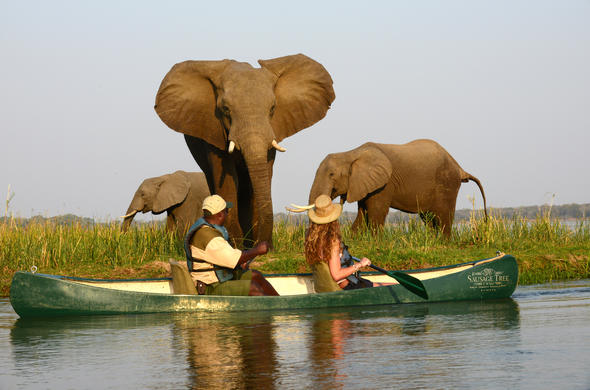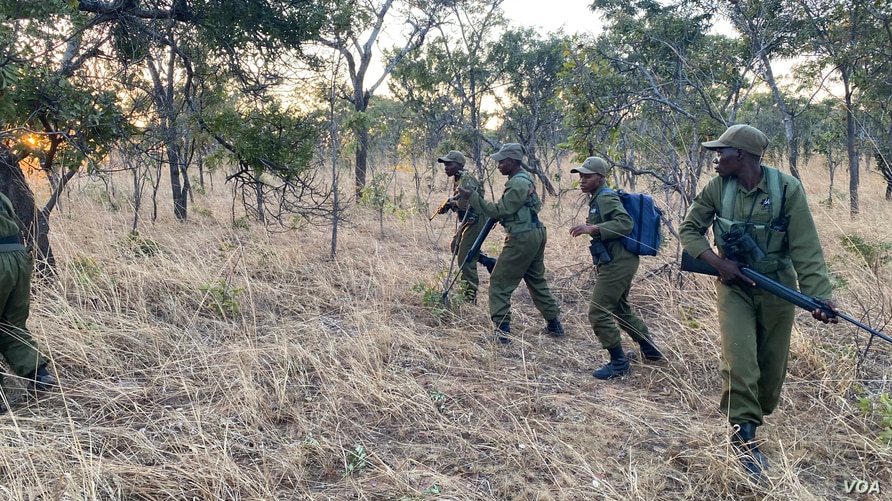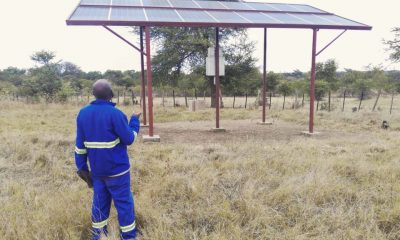Opinion
The nuisances that communities do to escalate human-wildlife conflict in the Zambezi Valley
Published
4 years agoon
By
VicFallsLive
BY BYRON ZAMASIYA
Human-wildlife conflict remains a significant problem in Zimbabwe among wildlife reliant communities and those that are adjacent to protected areas.
Smallholder farmers are losing crops, lives are being lost while some have suffered injuries due to this hazard.
Some smallholder farmers are using mitigation strategies that include chilli bricks, cattle bomas, lion tracking, vuvuzelas, torches, community wildlife conservancies, bee-hive boundaries, buffer crops, among others with varying successes.
In this blog, l focus on the nuisances that smallholder farmers do and their impact on incidences of human wildlife conflict in the Zambezi Valley.
If these little things are addressed, it is most likely that incidences of human-wildlife conflict will significantly fall not only in the Zambezi Valley but across the country.
The nuisances that communities do
Poorly built kraals for cattle and goats
Livestock, especially goats and cattle, are a significant safety net for smallholder farmers in wildlife reliant areas.
When the crops fail, the smallholder farmers augment their food supplies by selling livestock to raise much needed financial resources.
Despite the importance of livestock to household food security, most smallholders particularly in the Mbire District have poorly built kraals.
Most of them use tree branches with thorns to make what they call a kraal.
Others have kraals made from poles, but the distance between the poles is too large, making it easy for predators like lions, hyenas and leopards to fish out their prey easily.
The last group of farmers uses poles that are less than 1.5 metres.
These short poles make it easy for the predators to jump and feast on the livestock.
Smallholder farmers lack the understanding that when predators such as lions and hyenas hunt, they rely a lot on the “safety first principle”.
This principle implies that the predator considers its safety before attacking the prey.
Lions and hyenas would not attack livestock when their safety is very compromised.
This means that a poorly built kraal would easily enable a predator to attack the livestock.
Likewise, a well-built kraal will deter an attack by predators.
Trusting the “gods” to take care of livestock during the night
Those who have been to Mbire district know very well that if you go there after 7 PM, your biggest challenge is livestock sleeping on the roads.
The presence of goats on the roads at night clearly suggests that most smallholder farmers do not care where their livestock would be especially during the night.
It may also mean that those particular farmers do no treat either cattle or goats farming as business.
If they, who would risk letting their huge investments roam on the roads where there is a high risk of attack by predators?
When livestock roams on the roads at night, it is highly likely that predators such as lions, leopards and hyenas will attack the livestock.
Under such circumstances, even the Mbire “gods” are unable to protect the livestock.
The practice also exposes the livestock to the risk of being stolen by itinerant livestock buyers.
Poor siting of chilli buffer strings
Smallholder farmers are reporting that chilli buffer strings have a very positive effect on reducing incidences of HWC in the Zambezi Valley.
The chilli buffer strings are made from tobacco twine dipped in a mixture of grounded bird’s eye chillies and used oil.
The string is usually tied to two or more trees across a wildlife trek at least 200m-1000m away from the farmer’s fields.
The string is usually dipped again in the chilli and used oil mixture every two weeks if it’s not raining and weekly if it’s raining.
The idea behind the chilli strings is that elephants in particular observe boundaries.
Once they smell the chilli and oil on the string, they will reroute.
Elephants are also known to respect boundaries.
Wildlife such as warthogs and elands are also chased away by the smell of ground chillies and used oil. As such, tying chilli strings across wildlife treks has the effect of diverting their routes thus sparing the smallholder farmers’ fields.
Since the chilli string is tied at least 200m-1000m away from the crop field, the elephants would not be violent since they would not have seen any crops.
The strings are usually used during the crop growing season until the farmer harvests their crops.
However, most smallholder farmers who use chilli buffer strings continue to use the strings even after harvesting their crops.
While the smallholder farmers may enjoy some success as the elephants and other wildlife divert their treks, they will eventually get used to the technology rendering it ineffective.
Once that happens, the cases of HWC will escalate. Other farmers put the string right at the boundary of the crop field.
This practice is ineffective as the elephants become violent once they see the crops.
They will not reroute their treks resulting in the destruction of the crops.
If the farmer is lucky to deter the wildlife with the string that is right close to the field, the wildlife will vent their frustration in the neighbouring farmer’s fields where there are no chilli strings.
So, if wrongly used, chilli buffer strings will escalate incidences of HWC.
Grazing cattle in community wildlife conservancies
Water for livestock drinking is usually the main problem during the dry seasons for communities residing next to conservancies or those cohabiting with wildlife.
Although some operators may sink boreholes for communities in the buffer zone, in most cases, water is scarce for livestock drinking.
The absence of water for livestock drinking results in some communities illegally grazing their livestock in the conservancy close to water troughs for wildlife.
When this happens, the smallholder farmers expose their livestock to attacks by predators such as lions, hyenas, painted dogs and leopards.
While the cases of HWC may be low during the controlled grazing period, the livestock may trek to the conservancies on their own during the dry season.
It is during that time that the livestock will expose itself to attacks by predators.
This behaviour of grazing cattle in conservancies increases the chances of livestock picking zoonotic diseases and escalates incidences of HWC.
Selling cattle to safari operators for use as baits
In some cases, smallholder farmers in wildlife reliant areas sell their cattle to safari operators for use as baits during the trophy hunting season.
Smallholder farmers find the operators to be a good market for cattle as they do not have to travel to business centres to complete the transaction.
Some say there are no transaction costs in selling to safari operators.
The safari operators will slaughter the cattle and use them as baits. When this happens, predators may get used to the taste of cattle or goats.
As such, they may forget about the wildlife prey, which is difficult to catch and start preying on domesticated livestock.
When this happens, the cases of HWC will start to increase.
Lack of buffer zones between communities and conservancies
Buffer zones are a critical part of the communities that are reliant on wildlife resources.
A buffer zone can be as wide as 1km or more.
In most cases, the demarcation of a buffer zone is done in a participatory manner with the involvement of communities, council and safari operators.
Buffer zones provide communities with a source of non-timber forest products, grazing land, thatch grass, firewood and poles for other household construction purposes.
However, in some settlements, there are no buffer zones between communities and conservancies.
There are reports in some areas that communities refused the demarcation of buffer zones as they felt that this would decimate their fields for crop production.
The lack of a buffer zone means that communities and wildlife compete for resources within the conservancy.
Such communities are at high risk of wildlife encroachment which escalates incidences of HWC.
False problem animal control reports
When communities get sight of wildlife such as elephants, lions, etc., close to their homes or fields during the crop growing season, they usually report these to the councillor and the rural district council and the Zimbabwe Parks and Wildlife Management Authorities rangers.
However, the reality on the ground is that some communities have now developed a bad tendency of reporting problem animals when there are none.
Some report that their fields have been badly destroyed when in fact, such damage does not exist.
Unfortunately, the reports are usually sent straight to the Zimparks head office or other high-level officials circumventing the local authority and the ZimParks office.
Several cases that l have heard in Mbire district show otherwise.
Imagine the resources that would have been spent following up on false reports!
As such, the local ZimParks Office and the RDC may end up not responding to reports from such wards.
This is because they cannot waste limited resources pursuing such false reports.
When the community faces a real problem animal challenge in future, the RDC and ZimParks may not cooperate based on the previous learning.
This would lead to an escalation of incidences of HWC in the wards.
Visiting water holes at a similar time
Most community members visit water holes most pools or rivers at almost similar times daily.
This behaviour allows crocodiles to study the patterns and plan its attacks.
Since crocodiles rarely hunt in winter, they reserve their energy for the summer season when their hunting season opens.
Due to low energy levels, they use the “make sure principle”.
This means that they only attack the prey when they are very sure that they will succeed otherwise they will die from wasted energy.
Under such circumstances, crocodiles master the water hole visiting patterns of community members and time their attacks.
Maintaining similar times for visiting watering holes, therefore, escalates incidences of HWC.
Given these nuisances, what can communities and stakeholders do to reduce the incidences of HWC in the Zambezi Valley and other areas with similar contexts?
In this blog, l recommend the following solutions:
- Encourage livestock farmers to build strong kraals or adopt bomas
A key strategy to reduce incidences of HWC among wildlife-reliant communities is to encourage livestock farmers to build strong kraals with poles that are at least 1.5 metres tall and close to each other.
The poles should not afford the predators a chance to see the livestock.
An alternative is to adopt bomas. With bomas, the predators cannot see the livestock.
Based on the “safety first principle”, the predators will spare the livestock.
- Encourage farmers not to sell livestock to safari operators for use as baits
Although the market for cattle brought by safari predators may be lucrative, the selling of cattle for use as baits is not encouraged.
This is because once predators are introduced to livestock meat, they may become lazy to hunt and endanger domesticated livestock.
This is particularly the case with lions and hyenas.
- Ensure that buffer zones are marked
Considering the role of buffer zones, communities, the RDC, and the safari operators must demarcate a buffer zone.
- When reporting problem animals, encourage communities to report the reality on the ground.
Communities need to learn to report truthfully. Communities should also learn to follow the right reporting channel for problem animals.
This channel starts with the village head, councillor and then the RDC. It is the RDC that has to report to ZimParks.
Observing this hierarchy and sending factual reports can help communities to save the meagre financial resources.
- Restrict the use of chilli buffer strings to the growing season
Smallholder farmers need to understand that effective use of chilli buffer strings involves adhering to the rules.
During the offseason, the smallholder farmers need to remove all the chilli string buffers and allow the wildlife to move freely.
This can help to ensure that when the strings are used, the wildlife will not get used to them.
- Discourage grazing of cattle in conservancies
Although pastures may be scarce in wildlife reliant communities, the RDC and traditional leadership structures should ensure that the communities do not graze their cattle in conservancies.
This helps to maintain the value of the conservancy and reduce incidences of HWC.
- Break the water hole visiting patterns
Wildlife, such as crocodiles, are very good at studying patterns and timing their attacks.
Communities should ensure that they break the water hole visiting patterns.
This helps to disrupt the learning for crocodiles and reduce incidences of HWC.
Byron Zamasiya, is a natural resources economist at the Zimbabwe Environmental Law Association (Zela). This blog first appeared on the Zela website
You may like
Opinion
Makona ranger base in Hwange National Park: a keystone for protecting critical wildlife habitat
Published
3 years agoon
April 18, 2023By
VicFallsLive
BY AZZEDINE DOWNES
What began with a handshake at the Zimbabwe Parks and Wildlife Management Authority (ZimParks) headquarters roughly three years ago between two unlikely partners has now transformed into a long-term partnership that has played a key role in the protection and conservation of Zimbabwe’s iconic natural resources.
Marking a significant milestone in the partnership between IFAW and ZimParks, the Makona ranger base in Zimbabwe’s largest protected area—Hwange National Park—is now fully operational.
Hwange National Park is home to 150 species of mammals and designated as an important bird area with 400 distinct species and a population of elephants that is estimated to be around 45,000 individuals.
It is also a core part of the Kavango Zambezi Transfrontier Conservation Area (KAZA TFCA).
The establishment of the ranger base brings the partnership one major step closer to achieving its core mission: to protect the rich biodiversity of the area, conserve and enhance ecological processes, and secure key critical habitats while providing solutions that enhance ranger welfare holistically across an area spanning 14,651km2 acres.
The concept of enhancing ranger welfare is fundamental to ensuring the long-term success of the initiative.
Rangers must be fully dedicated to the objective at hand, as its breadth and scope are not for the faint of heart.
Leaving their families for months at a time, the work of a ranger demands a level of personal sacrifice that is often too easily overlooked.
Hence, the inauguration of the Makona ranger base serves needs that go beyond the functional and provides a foundational home and conducive working environment for a team who have chosen to undertake a way of life dedicated to the preservation of wildlife and the natural environment.
The base now includes ranger houses, an office complex, recreational centre, and an enhanced radio communications system.
The impact of all these investments has been significant, resulting in zero incidents of elephant poaching in IFAW-supported areas including Makona over the last three years.
Complementing this enormous success, the IFAW-ZimParks partnership is also investing in the development of sustainable tourism, providing key upgrades to campsites and lodges, and improving park visibility and viability through the construction of a new multi-purpose entrance gate and ancillary facilities.
As is the case with most effective partnerships, the one between IFAW and ZimParks is built upon trust, transparency, and friendship.
As the president and CEO of IFAW and as the director general of ZimParks, we are thrilled to celebrate this achievement together.
It is a testament to a mutual, long-term commitment to the protection and preservation of biodiversity, grounded in a partnership to deliver transformational change for people, wildlife, and the natural environment.
From our experience, the most successful conservation efforts are those which consider human connection—this is essential for enhancing the stewardship of natural resources across landscapes, regardless of size or culture.
These are some of the reasons why we recently upgraded the Dete Old Age Home, a well-known institution located on the periphery of Hwange National Park with the capacity to care for 40 senior citizens.
The community facility was made age-friendly through upgrades that included wheelchair access, representing just a few of the tangible results of conservation efforts which get transferred to the benefit of marginal local communities and institutions.
Other projects in the area include the installation of boreholes that provide easy access to potable water, directly improving community gardens that enhance nutritional health, and improved food security for local communities.
Another critical result worth highlighting has been the Environmental Stewardship Programme, an effort targeting schools in the outlying area of the park to build future environmental champions.
To enhance ‘conservation on the go’, the partnership has introduced a Pioneer Wildlife Ambulance in Zimbabwe, enhancing in situ care of both injured and sick animals while also undertaking efforts around disease surveillance.
Not only do the rangers now have the vehicles they need to reach animals in need of assistance, but also the enhanced patrolling capabilities that allow them to cover a far greater swath of the landscape than ever before.
Alongside the actual vehicles themselves, the roads have been upgraded to improve mobility, allowing the vehicles to traverse more effectively and with lesser damage.
Water supply for animals was also enhanced, providing a critical lifeline for wildlife as well as the surrounding human communities—minimizing the competition resulting from a limited water supply which is so often the source of human-wildlife conflict.
All of these results are essentially building blocks that serve as ideas that can be scaled up to fit the needs of other national parks across the landscape including Zambezi, Victoria Falls, and Kazuma Pan, all strategically located and critical for wildlife dispersal within the Kavango-Zambezi Transfrontier Conservation Area (KAZA TFCA).
The milestones (and more to come) achieved under this partnership are fundamental to the success of the Room to Roam initiative which seeks to secure connected spaces and safe passage for elephants and other wildlife, ultimately fostering harmonious coexistence with people.
Each milestone has served as an additional keystone for the foundation of our long-term partnership agreement of 25 years—and counting.
Though the first steps of practically any endeavour are usually the hardest, those taken by our respective organizations throughout this mutual partnership have been immensely fulfilling—for wildlife, for the local communities, and for the promise to a more prosperous future where the greatest beneficiary will no doubt be nature itself.
Written by Azzedine Downes, IFAW president and CEO and Dr. Fulton U. Mangwanya, director-general of Zimbabwe Parks and Wildlife Management Authority (ZimParks)
Opinion
Best things to do and places to stay in Victoria Falls, Zimbabwe
Published
3 years agoon
February 4, 2023By
VicFallsLive
BY URBANMATTER STAFF
Every traveller hopes to visit and experience Victoria Falls’ most enjoyable location at least once. However, traveling anywhere costs a lot of money, and seeing Victoria Falls in Zimbabwe is no exception. Naturally, you would also need to set aside some money for this. But how will you confirm that you have created the appropriate budget? Well, this inquiry is both pertinent and essential. Knowing every detail about the area is necessary to find the answer to this critical issue.
However, the second concern is where to find accurate and comprehensive information about Victoria Falls. Let’s congratulate you and say that this post is here to clear up any questions, worries, or misunderstandings you may have concerning this location. With the help of this article, citizens of the United Kingdom (UK) can find cheap flights to Zimbabwe. So let’s first look at Victoria Falls to see what it offers tourists, the ideal time to go, etc.
Overview of Victoria Falls, Zimbabwe
It is one of the giant water blankets on Earth, more than two kilometres wide at this point, and it thunderously descends through several basalt canyons before dropping 108 metres into a small pit. It is Africa’s fourth-longest river. On November 17, 1855, Scottish missionary and physician David Livingstone made the discovery. He named it Victoria in honour of the UK’s Queen Victoria. Both the Mosi-ao Tunya National Park in Zambia and the Victoria Falls National Park, situated on the Zimbabwean side of the Zambezi River, are included as UNESCO World Heritage Sites.
Victoria Falls National Park: On the Zimbabwean side, Victoria Falls National Park is a lush rainforest reserve with some of the best views of the falls. You can stroll along the park’s walkways, which wind through the rainforest and emerge with views from where you can see four of the five separate fall sections on this side. Crossing the border between Zimbabwe and Zambia is made simple by the Victoria Falls Bridge.
Batoka Gorge Swing: Everyone like swinging, right? This raises the bar considerably. You step off the platform while standing 120 meters above the swiftly flowing Zambezi River below. (Or you can run, jump, or dive; your “bravery/stupidity” determines the alternatives!)
Cruise on the river: You may anticipate seeing elephants, hippos, crocodiles, vervet monkeys, baboons, and birds throughout your two-hour trip. A late-afternoon boat trip is a fantastic way to take in the peace of the upper Zambezi and witness an unforgettable African sunset.
Bungee Jump: Why not attempt the 111-meter Bungee Jump from the Victoria Falls bridge’s centre? Consistently ranked as one of the top 5 bungees in the world, you have just 4 seconds to admire one of the seven wonders of the natural world before hurtling down to the river below! It is among the most exhilarating activities in Victoria Falls!
A helicopter journey is a beautiful method to comprehend Victoria Falls’ enormous immensity. The Mosi-oa-Tunya, or “The Smoke That Thunders,” mist wall that gives the location its local name will be passed over as you soar over the cascades on flights 12 and 13. As you soar above the Zambezi River, you’ll take in the beautiful sights of Batoka Gorge and keep an eye out for hippos or elephants. As a result, Victoria Falls, Zimbabwe, has more to offer than its counterparts here. Let’s shift to the essay’s next section, which discusses picking the ideal moment to travel there. You can find inexpensive flights from the UK to Victoria Falls, Zimbabwe, by using the following advice:
Weekday Flying: A low-cost airline must choose your flight dates, such as Tuesday or Wednesday. These weekdays were selected since they are frequently more affordable than other days. Getting the cheapet flight from the UK to wherever you worked during the week was more straightforward.
Stopover flight: It is recommended to go with airlines that provide indirect flights rather than direct flights. You might save a lot of money if you plan your trip. The cost of flying direct is prohibitive in comparison. Instead of squandering money, use the enjoyable “Indirect” mode of travelling.
Comparison: Another strategy to locate the most incredible travel deal is to compare flight ticket costs as much as possible. Thanks to it, you’ll be able to make decisions without hesitance or uncertainty. Because it broadens your knowledge and expertise, the comparison tactic is typically adequate. Compare all the airlines on your shortlist.
Being adaptable: If you live in the United Kingdom (UK) and want to visit Victoria Falls, you must choose the right time and dates for your vacation. You will pay more if you book a flight during a significant international holiday like Christmas or New Year’s. Flying tickets might sell out very quickly, depending on the circumstances.
Pre-booking: Book as far as you can to secure the best and most affordable flights. Almost always, making reservations three or six months in advance is a good idea. Travellers can benefit from substantial discounts, have plenty of time for reflection, add or delete any desired or unwanted items, etc.
Consequently, this article will assist you in reducing any confusion you may have about the location as it explains when to book your cheap flight, how to find inexpensive flights, how to keep your travel expenses down, and how to enjoy Victoria Falls, Zimbabwe, to the fullest. So, prepare for your path with clarity. – UrbanMatter
Opinion
Zimbabwean youths drink and smoke themselves to oblivion
Published
3 years agoon
August 25, 2022By
Staff WriterBY CLAYTON MOYO
“Ah, we won’t be having this crew in the next five years. “
“They are drinking and smoking themselves to oblivion,” says one of the patriarchs as we slaughter a neighbour’s beast in my village in southwestern Zimbabwe over the weekend.
He says so as he points at one of the young lads who has taken a break to gulp down a mouthful from a small bottle of what has become a popular alcoholic beverage across rural and high-density suburbs in Zimbabwe’s urban centres.
The alcoholic volume of the beverage is not immediately given in the package, as is the norm, but observing the sobriety plunge of one who indulges in a few gulps gives absolute pointers of extraordinary potency.
In the neighbour’s cattle kraal where we slaughter the beast in preparation for a feast, there are about five more young lads who are sharing the beverage, each small empty bottle thrown away goes with a substantial dosage of inhibitions and the chatter constantly threatens to teeter into a brawl.
They are not the only ones who pass the time brawling over alcohol.
In a period of more than a month, I have travelled to many parts of Matabeleland South and Bulawayo provinces coordinating a media and information literacy programme, and the participants in our meetings have been predominantly young women and the elderly.
After a few meetings, my curiosity gives in and I inquire.
“If you care so much about having young men in your meetings, go and conduct these training sessions from that bottle store,” said Edna Mpala, an elderly lady who oversees activities at Nyandeni Community Training Centre in Matabeleland South.
“We have lost them. They have all become useless.”
It is not too hard to establish why young people in rural and urban Zimbabwe have become “useless”.
Figuring out Zimbabwe’s unemployment rate is a fool’s errand. Convincing figures are elusive and some estimates go as high as 95 percent.
The World Bank database suggests 5.2 percent as of 2021, suggesting the majority of Zimbabweans are at work.
At first glance, that is quite positive, except I quickly learn that in Zimbabwe we no longer agree on what unemployment is – the economy has become so informal that such important economic activity indicators like employment rates are fluid.
Making a quick buck selling roasted maize at a dusty street corner before municipality police scatter your stock? Tick, you are employed!
But for those living in the country, the picture is vivid. Once bustling industrial areas of Belmont and Thorngrove in the city of Bulawayo now have lifeless premises, grass overgrown right at the gates.
Where there is life, a church ministry of one sort or another has taken over, aggressively manufacturing desperate believers who endlessly spend week-day evenings and weekends petitioning their creator for a miracle that will drive out misery.
In desperate times, you choose a pacifier. Young people have a different opiate of choice.
The alcoholism and drug abuse crisis in Zimbabwe has become so palpable and alarming that even the usually non-responsive policymakers are acknowledging the problem.
For quite a while, the spectacle of zombie-like young bodies, numbed by a cocktail of substances from alcohol to whatever else the street provides, was a distant story on South African television, narrating the nyaope crisis in Johannesburg.
It was never a familiar sight in Zimbabwean communities until it was. The street pavements in Harare and Bulawayo now have, on top of uncollected heaps of refuse, unsightly human bodies, stupefied by an assortment of substances.
The streets of Zimbabwe’s towns are churning out rare destructive ingenuity on improvising harmful substances as alternatives to expensive drugs.
From boiling diapers and sanitary pads, extracting whatever chemicals hit the right places to concoctions of cough mixtures and alcohol, sobriety has no chance, the possibilities of escaping it are endless.
The concerns of the patriarch in my village are pretty valid. The consumption of copious amounts of alcohol and drugs is not leaving any healthy body behind. Mental health is already flashing red.
The World Health Organisation reports that up to 57% of mental health cases in Zimbabwe are induced by drug abuse.
Statistics often capture those who turn up at formal health institutions. Dealing with mental health illnesses in Zimbabwean society is much more complex than seeking treatment for other ailments.
The burden of shame that families carry when one member develops a mental health condition creates a whole lot of “under the radar” treatment activities that happen away from medical specialists who can diagnose and offer appropriate treatment.
Spiritual prophets and traditional healers are the go-to for ailments that are believed to be “into zabantu” — afflictions speculated to be caused by witchcraft. Mental health conditions are almost invariably believed to be stirred by the jealous agitations of a relative, neighbour or colleague. On such issues, medicines administered by doctors are believed to be impotent.
Spiritual prophets and traditional healers do not have standard treatment protocols like medical professionals, and anything goes.
That includes rituals that could worsen a patient’s mental condition.
Their shrines form the busy margins where mental patients are surreptitiously dragged by relatives.
Zimbabwe’s Mental Health Act guarantees the treatment of mental patients, and treatment and admission at government psychiatric hospitals are free of charge. Great, on paper of course, like most things in the country.
The Zimbabwean healthcare system is facing an all-embracing assault from the economic crisis which no longer has traceable phases, one cycle overrides another.
Currently, inflation that has spectacularly eroded the salaries and living conditions of health workers is emptying hospital wards. Nurses and doctors have updated their passports and found work elsewhere. Young doctors who used to bitterly complain on social media about their working conditions have gone curiously quiet. There is no point in noisily walking away.
In 2021, Zimbabwe launched the National Drug Master Plan, which “offers both an integrated and comprehensive approach that will address a range of drug-related issues”.
The background section of the plan already betrays the reluctance in tracing illicit drug use in the country as it cites statistics from the Zimbabwe Republic Police’s criminal investigations reports of 2012.
There is a yawning gap between then and 2021.
The plan rightly captures the causes of drug abuse – the first one being poverty.
For most young people, there is no doubt that poverty pushes them to illicit drug use.
The proposed implementation matrix looks comprehensive as it claims, except there is no control of the drug abusers’ factory – the economic mess.
As long as Zimbabwe provides no work opportunities for the young lads in my village in Matebeleland South and indeed the rest of the country, the small bottles of alcohol will litter the place and inebriated bodies will compete for space with uncollected refuse in alleyways and pavements.
Back in the neighbour’s kraal, we finish off the half-charred pieces of meat, coated with a bit of ash as is the tradition – when a beast falls, the men who slaughtered it have the first braai at the kraal.
The young lads agree among themselves that it is a perfect day for a proper binge, as the meat has set a “base” for more alcohol. – Mail & Guardian
This is an edited version of an essay that was a runner-up in this year’s Canon Collins Trust “Troubling Power” Essay Competition.
*Clayton Moyo, a Canon Collins PhD scholar, is a digital media enthusiast teaching broadcast media at the National University of Science and Technology in Zimbabwe. He shares media skills outside the university with citizen journalists and emerging media entrepreneurs.
Trending
-

 Slider3 years ago
Slider3 years agoInnscor launches brewery to produce Nyathi beer
-

 National4 years ago
National4 years agoIn perched rural Matabeleland North, renewable energy is vital
-

 Tourism and Environment4 years ago
Tourism and Environment4 years agoStrive Masiyiwa’s daughter opens luxury Victoria Falls lodge
-

 Opinion4 years ago
Opinion4 years agoA street art mural in Zimbabwe exposes a divided society
-

 Special reports4 years ago
Special reports4 years agoTinashe Mugabe’s DNA show’s popularity soars, causes discomfort for some
-

 National4 years ago
National4 years agoVictoria Falls’ pilot dies in helicopter crash
-

 National3 years ago
National3 years agoCommission of inquiry findings fail to be tabled as Victoria Falls councillors fight
-

 National3 years ago
National3 years agoHwange coal miner fires workers over salary dispute
